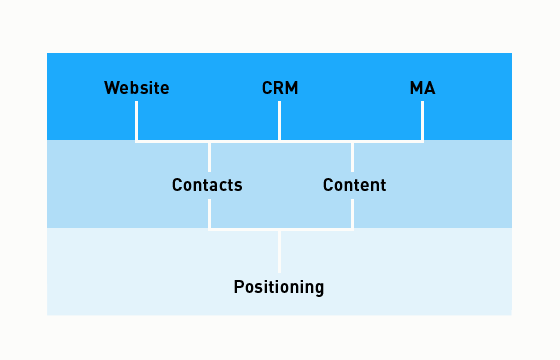Are you in control of your marketing?
Are you doing all you can to develop leads for your firm?
Of course you are.
But, just to make sure, why don’t you take this 10 second test I’ve created? Quickly answer each of the 4 questions I’ve listed below. I’ll give you 5 points for each “yes” and take away 5 for each “no.” If you earn a 10 or higher you’ve proven your expertise and you don’t have to read this newsletter, but earn a 5 or lower and your attention is all mine for the next 10 minutes. Deal?
OK, here it is:
- Do you know how much revenue you realized in Q1 from leads generated through the Contact Us form on your site?
- Do you know how many prospects in your email list meet your base demographic and behavioral criteria?
- Do you know which of those prospects have visited your site in the past month?
- …and which of those should you probably get in touch with today?
If you were able to honestly and confidently answer yes to at least three of the above questions, you’re free to go. If not, welcome to the rest of this newsletter…
The art of marketing is dead. It’s over. From this point forward, any marketing effort that is not entirely measurable is entirely useless. Thanks to the Great Recession, CEOs across the planet are sick of soft metrics and all of the non-measurable measurables they’ve been sold for the past five decades of marketing. This has been true for the Fortune 500 for a while, but now it’s true for the Fortune 5,000,000. If you can’t show decision makers how you’re making money for them, and how much of it you’re making, they’re no longer going to give you any.
Conversely, the science of marketing is alive and thriving. The system for meaningfully and specifically measuring marketing campaigns is now accessible to and affordable for businesses of all sizes.
This system is something we call The Digital Lead Development Ecosystem. It has six component pieces spread across three dependent layers. It’s entirely self contained and it’s as timeless as the web gets. Any business that recognizes the web as a viable marketing platform can use this system. Newfangled didn’t create any single aspect of it; we’ve just observed it, and we are very careful and constant practitioners of it.

Covering the entire Ecosystem would be beyond the scope of the newsletter format, so instead I would like to take a practical look at what we mean by lead development and highlight some of the most groundbreaking and profound aspects of the Ecosystem along the way. We’ll be focusing on the components in the top row of the chart above — the conversion-focused website, CRM (like Salesforce), and marketing automation (like Act-On, Marketo, and Pardot). If you’re interested in learning more about the Ecosystem, I encourage you to register for my ThoughtLegion webinar on the topic next month.
What is Lead Development?
Lead development is comprised of two things: lead creation and lead nurturing. The Digital Lead Development Ecosystem is responsible for both.
Lead Creation
The conversion-focused website is all about lead creation. In my book, “A Website That Works,” I discuss in detail how the conversion-focused site is responsible for attracting, informing, and engaging previously unaware prospects. This is how new leads get created. A prospect who needs you but perhaps doesn’t know you exist finds your site through some means (search, social, events, traditional advertising, word of mouth, referral,etc.) and is thereby attracted. Once there, they are informed by navigating through your site. They hopefully see your pricing and case studies to get a sense of what kind of work you do and whether or not they can afford you, and they will learn about your expertise through your site’s content strategy.
These tools — your pricing page, work examples, and expertise-based content — are the fine filters of your site. Their job, collectively, is to draw in the right prospects and filter out the wrong ones. Once the right prospects have been attracted and informed, your site’s job is to engage them through a call to action (a web form) that speaks specifically to the stage of the buying cycle they’re in. Someone who’s researching today for a problem they might pay to have solved down the road may only want to sign up for your newsletter, blog, or webinar. Someone who is a little further down the buying cycle path might be evaluating different solutions for their problem, and might be interested in filling out a needs assessment, downloading a white paper or an in-depth case study of work you’ve done for a client who is similar to them. Someone looking to make a hiring decision will want to speak with you.
It’s important that every page on your site have an option for people to engage with you, and it’s important that you’ve got good engagement options throughout your site for prospects in different stages of the buying cycle. With the Digital Lead Development Ecosystem, you can make sure that you’re engaging with your prospect in the stage of the buying cycle they are in today, and that’s a big deal.
Smart CTA’s With Progressive Profiling
Knowing which call to action is ideally geared toward each stage in the buying cycle on each page for every different prospect is impossible.
Just kidding, no it’s not. But until now it pretty much was. Because of the interplay between your conversion-focused site and marketing automation tool you can now keep track of who is on any given page of your site at any given time, check how they’ve already engaged on your site (assuming they have), review what you do know about them and don’t, and, based on all that information, decide which call to action you should show in the sidebar AND what information you should request from them in that CTA. This is powerful stuff, and it’s not quite as complicated as it sounds, especially if you at first forget about how this is happening behind the scenes and focus just on the effect.
For example, if someone has already signed up for your newsletter and in doing so gave you their first name, last name, and email, your site would know to never again ask them to sign up for the newsletter. Instead it would show them the next CTA you listed in order of preference, possibly based on the stages in the buying cycle. Also, since they’ve already given you their name and email, your site would never ask for that information again. Instead, it would ask for the next three things you’d like to learn about your prospect based on your progressive profiling scoring rules. Maybe it’s their title, company, and location—who knows, it could be anything. The main point here is that with the Lead Development Ecosystem in place, your site becomes far more intelligent. Since this same mechanism can be used to serve up custom content to individuals, the system allows you to serve your prospects in a far more customized fashion than you ever could before.
Lead Nurturing
The second part of lead development, after lead creation, is lead nurturing. Once your site has attracted, informed, and engaged your prospect it should then, in conjunction with your marketing automation tool, nurture them. Lead nurturing logic used to go like this: someone signs up to your monthly newsletter, they get it once a month forever and maybe, hopefully, some day they get your newsletter right when they realize they need to hire someone like you and call you up.
Lead Scoring
There’s nothing wrong with the above scenario, we’ve actually gotten a good deal of business that exact way over the years. The issue is that it’s a little soft — a little too much artful hope and not enough science.The Ecosystem version of it is more like this:
A prospect finds your site and signs up for your newsletter. In two hours, they automatically get a personal email from you thanking them for signing up and briefly describing what your business does. A week after they get the second newsletter, they automatically get another personal email from you asking how they’ve been enjoying the newsletter and letting them know you’d be happy to have a conversation if they’re ever interested in learning more about what you do.
Over time they go back to your site every so often and are invited to do different things based on what they’ve already done and not done. As they continue to engage in different ways, you learn more about who they are demographically and what they’re doing on your site — all of which you’re keeping track of. This info — the demographic and activity data you’re collecting — is what you use to score your leads.
The Rebirth of the Cold Call
As you nurture your leads, you’re keeping score based on who they are and what they’re doing. When you have the Ecosystem in place, you can create alerts based on communication between the site, CRM, and marketing automation tool that tell you when the right sort of prospect has done enough of the right things to warrant a personal review by you.
Many businesses have at least thousands if not tens or sometimes hundreds of thousands of active leads in the system they are nurturing. If their site is doing its job they’re getting many more every single month. Once you hit about 300 leads in your system, you no longer have time to personally review each one of them for sales readiness. In the past, I’ve felt guilty for not knowing my lead database as well as I should — how many potential customers are in there with whom I should be in closer contact? I didn’t know; I couldn’t know.
Now I know. The Ecosystem is nice enough to email me the moment an ideal prospect has hit a lead score that indicates they are ready for me to review, and, if my review of their activity goes well, I get in touch with them. (Imagine how powerful this could be for companies with sales reps all over the country, continent, or planet — the right rep would be notified when the right prospect in their territory did all the right things!)
I hate cold calling. Of course, I only know that because I’ve done plenty of it over my career, but three years ago, I vowed to never do it again. So far, so good. My prime motivator to invest so heavily in the kind of educational content-based marketing Newfangled does so much of — the newsletters, blogs, webinars, articles, talks, books — is that I never ever want to have to cold call. Like, ever.
But now I love cold calling, but only because it’s not all that cold. When I reach out to someone who I know is the perfect prospect for us, and who as done all the right things on our site, but for whatever reason just hasn’t taken that last step of proactively getting in touch with us, it is inevitably a great conversation. I don’t lead by saying that I’ve been watching them on our site (although they find that out quickly enough), I just start by saying that I noticed that our site’s been a good resource for them, and I ask if they have a few minutes for a call.
The fact that this is possible is groundbreaking, and it completely changes the nature of how we think about and use our websites. It changes the way marketing works, and it’s only possible when you’ve got the Digital Lead Development Ecosystem in place.
After Lead Development
Unless you have an E-Commerce site, the Digital Lead Development Ecosystem is never going to close a deal for you. It is a marketing tool, and, as such, its job is to develop leads and then hand them off to the right salespeople based on their demographic and behavioral information. Once the prospect does metamorphose into a customer, though, the Ecosystem comes back into play.
True Marketing Measurement
Remember the first question in my little quiz at the beginning of this newsletter, the one about revenue from leads generated through the Contact Us form? Well, I can tell you that in Q1 we closed $146,000 worth of business over 4 projects that had our Contact Us form as the lead source. I can also give you the numbers for our webinars, newsletter, blog signup, and any other online or offline campaign we’ve conducted.
This is only possible because of the interplay between our site, CRM, and marketing automation tool. In this case, the site attracted and informed the leads, and they finally engaged through the Contact Us form. At that moment, we began tracking their activity on the site, and they were instantly and automatically created as a lead, contact, and opportunity in the CRM, and they went through the appropriate lead nurturing campaigns in the marketing automation tool — all of which were tracked in all three places. After they closed, they were added to our revenue report inside of the marketing automation system, and now I know exactly what efforts and lead sources have the most significant impact on revenue. As one of those care-not-for-fluff CEOs I described at the beginning of this newsletter, I really like that.


